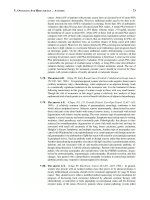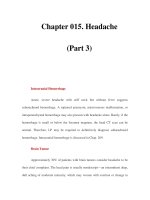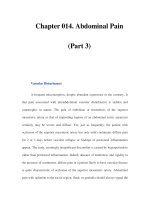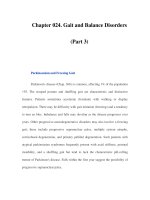Chapter 110. Coagulation Disorders (Part 3) pdf
Bạn đang xem bản rút gọn của tài liệu. Xem và tải ngay bản đầy đủ của tài liệu tại đây (12.26 KB, 5 trang )
Chapter 110. Coagulation Disorders
(Part 3)
Clinically, hemophilia A and hemophilia B are indistinguishable. The
disease phenotype correlates with the residual activity of FVIII or FIX and can be
classified as severe (< 1%), moderate (1–5%), or mild (6–30%). In the severe and
moderate forms, the disease is characterized by bleeding episodes into the joints
(hemarthroses), soft tissues, and muscles after minor trauma or even
spontaneously. Patients with mild disease experience infrequent bleeding that is
usually secondary to trauma. Among those with residual FVIII or FIX activity
>25% of normal, the disease is discovered only by bleeding after major trauma or
during routine presurgery laboratory tests. Typically, the global tests of
coagulation show only an isolated prolongation of the aPTT assay. Patients with
hemophilia have normal bleeding times and platelet counts. The diagnosis is made
after specific determination of FVIII or FIX clotting activity.
Early in life, bleeding may present after circumcision or rarely as
intracranial hemorrhages. The disease is more evident when children begin to walk
or crawl. In the severe form, the most common bleeding manifestations are the
recurrent hemarthroses, which can affect every joint but mainly affect knees,
elbows, ankles, shoulders, and hips. Acute hemarthroses are painful, and clinical
signs are local swelling and erythema. To avoid pain, the patient may adopt a fixed
position, which leads eventually to muscle contractures. Very young children
unable to communicate verbally show irritability and a lack of movement of the
affected joint. Chronic hemarthroses are debilitating, with synovial thickening and
synovitis in response to the intraarticular blood. After a joint has been damaged,
recurrent bleeding episodes result in the clinically recognized "target joint," which
then establishes a vicious cycle of bleeding, resulting in progressive joint
deformity that in critical cases requires surgery as the only therapeutic option.
Hematomas into the muscle of distal parts of the limbs may lead to external
compression of arteries, veins, or nerves, which can evolve to a compartment
syndrome.
Bleeding into the oropharyngeal spaces, central nervous system, or the
retroperitoneum is life-threatening and requires immediate therapy.
Retroperitoneal hemorrhages can accumulate large quantities of blood along with
formation of masses with calcification and inflammatory tissue reaction
(pseudotumor syndrome), and they can also result in damage to the femoral nerve.
Pseudotumors can also form in bones, especially long bones of the lower limbs.
Hematuria is frequent among hemophilia patients, even in the absence of
genitourinary pathology. It is often self-limited and may not require specific
therapy.
Hemophilia: Treatment
Without treatment, patients with severe hemophilia have a limited life
expectancy. Advances in the blood fractionation industry during World War II
resulted in the realization that plasma could be used to treat hemophilia, but the
volumes required to achieve even modest elevation of circulating factor levels
limits the utility of plasma infusion as an approach to disease management. The
discovery in the 1960s that cryoprecipitate fraction of plasma was enriched for
FVIII, in addition to the eventual purification of FVIII and FIX from plasma, led
to the introduction of home infusion therapy with factor concentrates in the 1970s.
The availability of factor concentrates resulted in a dramatic improvement in life
expectancy and in quality of life for people with severe hemophilia. However, the
contamination of the blood supply with hepatitis viruses and, subsequently, HIV
resulted in widespread transmission of these bloodborne infections within the
hemophilia population; complications of HIV and of hepatitis C are now the
leading causes of death among US adults with severe hemophilia. The introduction
of viral inactivation steps in the preparation of plasma-derived products in the
mid-1980s greatly reduced the risk of HIV and hepatitis, and the risks were further
reduced by the successful production of recombinant FVIII and FIX proteins, both
licensed in the 1990s. It is uncommon for hemophilic patients born after 1985 to
have contracted either hepatitis or HIV, and for these individuals, life expectancy
is in the range of 65 years of age.
Factor replacement therapy for hemophilia can be provided either in
response to a bleeding episode or as a prophylactic treatment. Primary prophylaxis
is defined as a strategy for maintaining the missing clotting factor at levels ~1% or
higher on a regular basis in order to prevent bleeds, especially the onset of
hemarthroses. Hemophilic boys receiving regular infusions of FVIII (3 days/week)
or FIX (2 days/week) can reach puberty without detectable joint abnormalities.
Although highly recommended, this regimen is performed for <30% of patients
because of the high cost, difficulties in accessing peripheral veins in young
patients, and the potential infectious and thrombotic risks of long-term central vein
catheters.
General considerations regarding the treatment of bleeds in hemophilia
include (1) the need to begin the treatment as soon as possible because symptoms
often precede objective evidence of bleeding; because of the superior efficacy of
early therapeutic intervention, classic symptoms of bleeding into the joint in a
reliable patient, headaches, or automobile or other accidents, require prompt
replacement and further laboratory investigation; and (2) the need to avoid drugs
that hamper platelet function such as aspirin or aspirin-containing drugs; to control
pain, drugs such as ibuprofen or propoxyphene are preferred.









